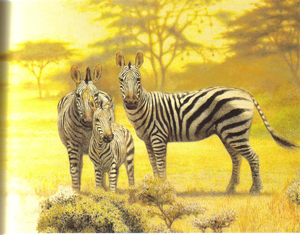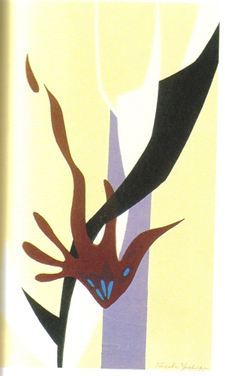Childhood Influences
A very important developmental stage of life takes place during childhood. During this stage, many different factors play a part in the shaping of the person. One of the most imperative factors in a child’s life is family. The importance of the role of family is highly evident when viewing the relations of the Yoshida household. Toshi and Hodaka were both sons of the great artist, Hiroshi. From a young age they had much to live up to. In the Japanese culture, birth order was the force that assigned certain roles to certain children. Due to this, different expectations were placed on the two Yoshida sons. These differing pressures from their parents and other childhood factors are what led to the development and varying styles of art produced by Toshi and Hodaka.
There were many different factors that helped to lead Toshi toward his eventual artistic path. Toshi grew up in a financially stable family, but money did not guarantee a happy and healthy childhood. At a very young age, Toshi contracted polio, which made it impossible for him to play like most other children his age. He instead turned to drawing in sketchbooks. These books were filled with a variety of imaginative animal adventures. The sketchbooks acted as games and conversations that he held with friends and family. It was from these drawings that Toshi was able to exercise his imagination and gain his talent in portraying animals. He also had a strong sense of inner motivation to put his artistic talents to use. Toshi credited the combination of these factors as the reason for his artistic development
Even though Toshi based his entry into the art profession on his personal experiences during childhood, there can be no doubt that his father also played a very strong role in his artistic outcome. Due to the fact that Toshi was Hiroshi’s first son, great discipline and expectations were placed upon him. Both parents created an environment in which Toshi’s artistic talent was to flourish and follow in the footsteps of the family tradition. His Grandmother Rui on the other hand, acted as a gentle force and gave him emotional support. She also helped to suggest a path for his development. What is ironic is the fact that Hiroshi put such a great deal of pressure on Toshi to become an artist and filled his childhood with artistic training, yet Toshi gave more credit to his grandmother than to his parents for his transformation into an artist. He followed his grandmother’s suggestion, and in his first works depicted animals and used the medium of woodblock prints. Many compared him to his father, since his father was depicting nature and also using the same medium at the time.
There lies great contrast when comparing the childhood and eventual path of Toshi to his brother, Hodaka. Hodaka also experienced health problems during his childhood. Starting in kindergarten, he experienced frequent asthma attacks, but overall, his childhood health was much better than his brother’s. Since Hodaka was the second son of Hiroshi, there was no pressure placed upon him to become an artist. Instead, he was placed on a track that lead him to the sciences. His family knew that the only way he would be able to avoid joining the military would be for him to study science. He attended a university level school, but had to take a temporary leave in 1944 due to World War II.
It was during this time away from school that Hodaka began to experiment with poetry and oil painting. Late at night, he would experiment with abstract paintings in the attic of the Yoshida household. He chose the abstract style in order to differentiate himself from his father and brother. Neither of his parents knew of his actions, but Toshi eventually found out and joined him in his late night drawing sessions. Hodaka submitted one of his abstract paintings to the annual Pacific Painting Society exhibition. His father was one of the founders of this society, yet was left unaware of his son’s entry into the exhibit. When the jurors decided to give the painting an award, they made Hiroshi present it. He was surprised to find his own son receiving the award and gave Hodaka no personal recognition. Instead, both of his parents seemed disappointed with him. Hodaka had once said that if his father would have said anything to him about his award winning painting, it would have been along the lines of, “You call this art?” This, however, did not stop Hodaka from painting abstract art. The changing cultural climate after the war brought along a new freedom, which was a strong factor that led Hodaka down the artistic path.
The differing forces in the Yoshida son’s lives are what lead to the vastly unique developments of their varying artistic styles. The eldest son followed closely to his father’s style, yet put his own unique touch on his works. Unfortunately, Toshi encountered great scrutiny throughout his career from critics claiming he was not branching out for himself, but just following his father’s standards. On the other hand, Hodaka created works of art that were very different from his father and brother. There was an ironic twist in the chosen artistic styles of the Yoshida sons closely following the death of Hiroshi in 1950. In 1951, Hodaka began to use woodblock as a medium, while in 1952, Toshi began to experiment with abstract art. The change of artistic styles help to give insight on the pressure put upon them by their father. Perhaps Hiroshi’s death brought on a new freedom, which allowed the two Yoshida sons to experiment in ways that may not have been accepted by their father.
Laura W. Allen et al., A Japanese Legacy: Four Generations of Yoshida Family Artists (Chicago: Art Media Resources, Ltd., 2002), 72.
Eugene M. Skibbe, Yoshida Toshi: Nature, Art and Peace (Edina: Seascape Publications, 1996), 36.
Eugene M. Skibbe, Yoshida Hodaka: The Magic of Art (Edina: Seascape Publications, 1997), 12.
Woodblock print entitled Black Flower, created by Hodaka in 1952
Woodblock print entitled Gift Red, created by Hodaka in 1962 
Oil on canvas entitled Zebras created by Toshi in 1978
References
Eugene M. Skibbe, Yoshida Hodaka: The Magic of Art (Edina: Seascape Publications, 1997).
Eugene M. Skibbe, Yoshida Toshi: Nature, Art and Peace (Edina: Seascape Publications, 1996).
Laura W. Allen et al., A Japanese Legacy: Four Generations of Yoshida Family Artists (Chicago: Art Media Resources, Ltd., 2002).

